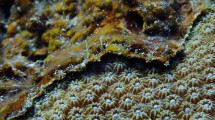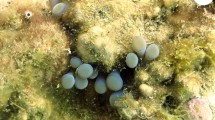Abstract
This study of ten Indo-Pacific and Caribbean scleractinian corals explains their relative aggressive proficiencies in terms of their cnidoms. Species ranging from aggressive to subordinate, on an established hierarchy, were studied. Size, number and distribution of each cnida type were quantified. A marked relationship between number of nematocysts per polyp and aggressive proficiency was demonstrated. The recorded differences in aggressive proficiency between the Indo-Pacific and Caribbean corals are discussed in terms of cnidom differences. In two species a significant trend in linear distribution of nematocysts along mesenterial filaments was recorded, with a distinct zonation of the different nematocyst types along the length of the filament.
Similar content being viewed by others
References
Bak RPM, Brouns JJWM, Heys FML (1977) Regeneration and aspects of spatial competition in the scleractinian corals Agaricia agaricites and Montastrea annularis. Proc 3rd Int Coral Reef Symp 1:143–148
Bak RPM, Termaat RM, Dekker R (1982) Complexity of coral interaction: influence of time, location and epifauma. Mar Biol 69:215–220
Bothwell AM (1981) Fragmentation, a means of asexual reproduction and dispersal in the coral genus Acropora (Scleractinia: Astrocoeniidae: Acroporidae)—a preliminary report. Proc 4th Int Coral Reef Symp 2:137–144
Bothwell AM (1983) Toppling, contact overgrowth and extracoelenteric digestion among corals and the intermediate disturbance hypothesis. Aust Coral Reef Soc, Abstr, Annu Sci Meet, Brisbane 16–21
Bradbury RH, Young PC (1981) The race and the swift revisited, or is aggression between corals important? Proc 4th Int Coral Reef Symp 2:351–356
Bradbury RH, Young PC (1983) Coral interactions and community structure: an analysis of spatial pattern. Mar Ecol Prog Ser 11:265–271
Burnett AL, Davison R, Wiernik P (1963) On the presence of a feeding hormone in the nematocysts of Hydra piradi. Biol Bull 125:226–233
Carlgren O (1940) A contribution to the knowledge of the structure and distribution of the cnidae in the Anthozoa. Acta Univ Lund (Ard 2) 36 (3):1–62
Chornesky A, Williams SL (1983) Distribution of sweeper tentacles on Monastrea cavernosa. Symp Ser Undersea Res 1:61–69
Connell JM (1973) Population ecology of reef-building corals. In: Jones O, Endean R (eds) Biology and geology of coral reefs, vol II, Biol I. Academic Press, London New York, pp 205–245
Connell JM (1976) Competitive interactions and the species diversity of corals. In: Makie GO (ed) Coelenterate ecology and behaviour. Plenum Press, London, pp 51–58
Cope M (1981) Interspecific coral interactions in Hong Kong. Proc 4th Int Coral Reef Symp 2:357–362
Ewer RF (1947) On the functions and mode of action of the nematocysts of Hydra. Proc Zool Soc Lond 117:365–376
Francis L (1973) Intraspecific aggression and its effect of the distribution of Anthopleura elegantissima and some related anemones. Biol Bull 144:73–92
Goreau TF (1956) A study of the biology and histochemistry of corals. PhD thesis, Yale University
Hyman LH (1940) The invertebrates: protozoa through Ctenophora, vol 1. McGraw-Hill, London, pp 365–369
Gray P (1954) The microtomist's formulary and guide. Constable, London, p 794
Harriot VJ (1983) Reproductive seasonality, settlement and post-settlement mortality of Pocillopora damicornis (Linneus) at Lizard Island, Great Barrier Reel. Coral Reefs 2:151–157
Hartog Den JC (1977) The marginal tentacles of Rhodactis sanctithomae (Corallimorpharia) and the sweeper tentacles of Montastrea cavernosa (Scleractinia), their cnidom and possible function. Proc 3rd Int Coral Reef Symp 1:463–470
Hidaka M, Yamazato K (1984) Interspecific interactions in a scleractinian coral, Galaxea fascicularis: induced formation of sweeper tentacles. Coral Reefs 3:77–85
Hildemann WH, Raison RL, Hull CJ, Akaka L, Cheung G (1977) Tissue transplantation immunity in corals. Proc 3rd Int Coral Reef Symp 1:537–543
Johnston I (1977) Aspects of the structure of a skeletal matrix and the process of skeletogenesis in the reef coral Pocillopora damicornis. Proc 3rd Int Coral Reef Symp 2:447–453
Lang J (1970) Interspecific aggression within the scleractinian corals. PhD thesis, Yale University
Lang J (1971) Interspecific aggression by scleractinian corals. 1: The rediscovery of Scolymia cubensis (Milne-Edwards and Haime). Bull Mar Sci 21:952–959
Lang J (1973) Interspecific aggression by scleractinian corals. 2: Why the race is not only to the swift. Bull Mar Sci 23:260–279
Lenhoff HM (1971) Research on feeding, digestion and metabolism in coelenterates: Some reflections. In: Lenhoff HM, Muscatine L, Davis LV (eds) Experimental coelenterate biology. Univ Hawaii Press, Hawaii, pp 75–83
Logan A (1984) Interspecific aggression in hermatypic corals from Bermuda. Coral Reefs 3:131–138
Manuel RL (1981) British Anthozoa: Keys and notes for the identification of the species. Academic Press, London New York, p 241
Mariscal RN, McLean RB, Hand C (1977) The form and function of cnidarian spirocysts Pt 3. Ultrastructure of the thread and the function of spirocysts. Cell Tiss Res 178:427–434
May RM (1973) Stability and complexity in model ecosystems. Princeton University Press, Princeton, p 235
Muscatine L (1973) Nutrition of corals. In: Jones QA, Endean R (eds) Biology and geology coral reefs, vol II. Academic Press, London New York, pp 77–115
Ohlhorst SL (1984) Spatial competition on a Jamaican coral reef. Advances in Reef Science. Abstr of a joint meeting of the Atlantic Reef Committee and the International Society for Reef Studies, University of Miami, Miami, pp 91–92
Potts DC (1976) Growth interactions among morphological variants of the coral Acropora palifera. In: Mackie GO (ed) Coelenterate ecology and behaviour. Plenum Press, London, pp 79–88
Potts DC (1978) Differentiation in coral populations. Atoll Res Bull 220:55–74
Purcell JE (1977) Aggressive function and induced development of catch tentacles in the sea anemone Metridium senile (Coelenterata; Actiniaria). Biol Bull 153:355–368
Randall RH (1981) Morphological diversity in the scleractinian genus Acropora. Proc 4th Int coral Reef Symp 2:157–164
Richardson CA, Dustan P, Lang J (1979) Maintenance of living space by sweeper tentacles of Montastrea cavernosa, a Caribbean coral. Mar Biol 55:181–186
Rosen BR (1975) The distribution of reef corals. Rep Underwater Assoc 1:1–16
Schmidt H (1969) Die Nesselkapseln der Aktinien und ihre differential-diagnostische Bedeutung. Helgol Wiss Meeresunters 19:284–317
Schmidt H (1972) Prodromus zu einer Monographie der Mediterranean Aktinien. Zoologica (Stuttgart) 42 (Heft 121):1–146, 26 pls
Schmidt H (1974) Evolution in the Anthozoa. Proc 2nd Int Coral Reef Symp. 1:533–562
Sheppard CRC (1979) Interspecific aggression between reef corals with reference to their distribution. Mar Ecol Prog Ser 1:237–247
Sheppard CRC (1981) ‘Reach’ of aggressively interacting coals and relative importance of interactions at different depths. Proc 4th Int Coral Reef Symp 2:363–368
Sokal RR, Rohlf FJ (1981) Biometry: the principles and practice of statistics in biological research. Freeman, San Francisco, p 859
Suchanek TH, Carpenter RC, Whitman JD, harvell CD (1983) Sponges as important space competitors in deep Caribbean coral reef communities. Symp Ser Undersea Res 1:55–60
Wallace CC (1978) The coral genus Acropora (Scleractinia: Astrocoeniina: Acroporidae) in the Central and Southern Great Barrier Reef Province. Mem Queensl Mus 18(2):273–319, pls 43–103
Wellington GM (1980) Reversal of digestive interactions between Pacific reef corals: mediation by sweeper tentacles. Oecologia 47:340–343
Author information
Authors and Affiliations
Rights and permissions
About this article
Cite this article
Thomason, J.C., Brown, B.E. The enidom: an index of aggressive proficiency in scleractinian corals. Coral Reefs 5, 93–101 (1986). https://doi.org/10.1007/BF00270357
Accepted:
Issue Date:
DOI: https://doi.org/10.1007/BF00270357




